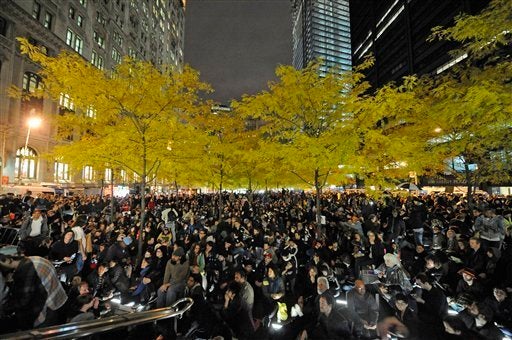
When the NYPD evacuated Zuccotti Park, forcibly removing the protesters who had made the public space their nerve center, organizational laboratory, and home for more than two months, they brought to a close a significant chapter of the Occupy crusade. While its populist message of frustration with government dysfunction, financial regulation, and joblessness undoubtedly impacted the American political dialogue, the effort's long-term effects remain to be seen. Regardless of whether or not Occupy Wall Street and its sister organizations become catalysts for systemic change (or your political perspective on the merits of reform) the protesters have taught us a number of critical lessons about mobilizing movements that leaders -- whether business, political, or non-profit -- should bear in mind.
Balance consensus with decree. One of the most distinctive features of the Occupy movement is its embrace of a highly participatory, democratic means of decision-making otherwise known as the General Assembly. The details of General Assembly management are somewhat complex, but they're grounded in a simple process. Any participant may bring to the table a proposal for the group's discussion. A facilitated conversation ensues that seeks to establish consensus -- defined in this case as the absence of "outright opposition." If consensus is achieved, the proposal is put into action. Otherwise, participants may rework proposals and reintroduce them for further debate.
What's great about the General Assembly is the way it engages participants in dialogue and makes them integrally involved in shaping the way forward. When decisions are finally made, they're more likely to be pursued with dedication since they're created by team members rather than imposed on them. On the other hand, consensus-based decision-making -- especially among large groups like the 2,000 plus OWS protesters -- is incredibly slow.
Giving every person with a perspective equal opportunity to share and participate in debate is a recipe for inaction. As leaders, our job is to establish forums for bottom up feedback without promising an equal measure of "air-time" or credence to all team members. Gather ideas, host discussions, confer with advisors, but retain decision-making authority. Whenever possible, resist the temptation to divvy up accountability for making the call. Execution works best when there's one person at the helm.
Inspire through emotion; support through community. There's a lot about Occupy Wall Street that's illogical: picking a fight with a faceless political-economic system, camping out in downtown Manhattan, drum circles. And yet thousands of people dedicated their lives to the occupation for months on end. They self-organized into working groups, cooked meals, and cleaned up each other's mess. They launched a media hub and established a library. They marched. They chanted. Some got arrested rather than abandon their convictions. No one got paid. There were no bonuses awarded for superior performance.
You don't inspire this kind of behavior through rational appeals. There is no "business case" that motivates people to sacrifice and give of themselves so passionately. To mobilize movements, participants have to be emotionally connected to the work at hand. There must be a force bigger than profits or prestige that calls them forward. And to sustain that momentum in the face of the challenges that confront any group, there needs to be a sense of togetherness that binds individuals to one another. We are social beings. We yearn for community. When we triumph and when we fail, we turn to one another -- for celebration or for the strength to carry on.
Can you identify the cause that anchors your organization and inspires your colleagues to bring their best to work everyday? Is it something simple and human? Does it tap your emotions and capture your imagination? Once you've nailed it -- and you'll know it when you have -- rally your teams around that cause and remind them of it daily. Then, take a moment to consider the nature of your organization's community. Does it balance a drive for performance with caring and compassion for team members? Does it value the personal and professional growth of its members as it values the bottom line? Is it a community you're proud to lead and be a part of? If your answer is anything less than an emphatic "Yes!" consider what needs to be done to move in that direction.
Power off and tune in. One of the restrictions placed on the protesters in New York was a ban on the use of amplification. The idea was to limit the "sound pollution" inflicted on local residents and businesses. This may not seem so significant out of context, but the absence of mics was a big hurdle for a group of thousands of people trying to communicate with one another. From that challenge was born an innovative solution -- the human microphone. Here's how it works. The speaker shares a short burst of commentary. The crowd -- particularly those closest to the speaker -- repeats what was spoken in unison, so those in back can hear. For particularly large assemblies, the crowd might use several waves of repetition to ensure all those attending register the speaker's words. It's not the most efficient means of public speaking, but there is something powerful in the human microphone's ability to capture participants' attention. The absence of technology prioritizes the message over the medium and builds an almost tribal bond between those involved.
In the modern workplace, most of us spend our days sitting alone behind computer screens. Our teams are often virtual with colleagues dispersed around the world. We communicate and engage with one another via email, instant messaging, and social media. Many of our meetings are phone calls, or if we're lucky, videoconferences. There are fewer and fewer opportunities to gather together in the same room. The strong ties built on face-to-face interaction have been replaced by the relatively weak connections afforded to us through technology. That's not to say that technology is bad. To the contrary, it can be a powerful enabler of cross-organizational connectivity. But it cannot replace the power of human interaction. The Occupy level commitment that leaders need of their people to support a large-scale transformation, break into a new market, or launch a disruptive product demands a reinvestment in face time.
Whether you're a senior leader or a new manager, consider what would happen if you made the decision to power off -- if only briefly -- in 2012. What kind of ideas would be generated if you got up from your computer and walked down to your colleague's desk the next time you have to speak with her? How might the investment to fly to your next divisional meeting and engage face-to-face with your team members pay itself off? What if you canceled your lunch date with Facebook and booked a team get together instead? It's tough to measure the dollar value of recommitting to building real, human connections with your coworkers, but the trust you will engender among colleagues will no doubt rise. From a leadership perspective, if your people trust you -- if they have confidence that you have their best interests in mind -- they'll follow you anywhere. And even if you're not a leader, you'll find your work experience much more satisfying when it's shared with people, not just machines.
Occupy Wall Street may seem like an unlikely source of leadership and organizational wisdom. But before you dismiss the protesters, consider that great ideas often come from the fringe and what's counter-cultural today becomes mainstream tomorrow. Regardless of your political persuasion, the Occupy movement illustrates valuable lessons about decision-making, community building, and what it takes to inspire a group of people to dedicate themselves wholeheartedly to a cause.
What's the first step you'd take to occupy your company?
